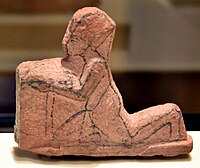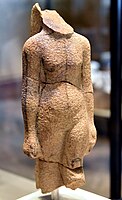Deutsche Orient-Gesellschaft
The Deutsche Orient-Gesellschaft (German: .
The DOG was officially founded in January 1898 to foster public interest in
Bible lands in the late 19th century. DOG focused on the cultures of the Middle East from early times to the Islamic
period.
The founders of the DOG included a number of well-connected members of German society, including
Kaiser Wilhelm II developed an interest in archaeology and took the DOG under his protection from 1901, funding excavations with grants from Imperial funds. It was officially a subsidiary of the German museum administration, so its finds automatically belonged to the Prussian state. Further, its activities were aided by friendly relations established between the German and Ottoman Empires
.
The DOG's activities were interrupted by the
World Wars. The DOG was reestablished in 1947, and celebrated its centennial at the Pergamon Museum
in Berlin in 1998.
Excavations
DOG undertook excavations in
Nebuchadnezzar, and the Hanging Gardens of Babylon. Koldewey also claimed to have discovered the Tower of Babel
.
Ägyptisches Museum, was discovered among other sculptural artefacts in the workshop of the sculptor Thutmose
.
Hattuša. Other excavations before the First World War took place at sites at across the Fertile Crescent - in Mesopotamia, Turkey, Palestine and Egypt - including Megiddo, Capernaum, Borsippa, Hatra, Jericho, Kar-Tukulti-Ninurta, and Uruk, but the outbreak of the First World War
in August 1914 terminated DOG's excavations.
After the DOG was reestablished following the Second World War, more recent excavations have taken place at
in 1999.The DOG produces the annual publications, Mitteilungen der Deutschen Orient-Gesellschaft (MDOG) and Alter Orient aktuell.
Gallery
Some artifacts excavated by the German Oriental Society at Tell el-Amarna, Egypt, 1911-1914:
-
Unfinished figurine of a kneeling Egyptian pharaoh holding a table. From Amarna, House P47.1, Room 5. Neues Museum, Berlin
-
Fragments of a royal portrait, templet of nose and lips. From Egypt, Amarna, Neues Museum, Berlin
-
Unfinished statuette of an Amarna pharaoh. From Egypt, Amarna, House P47.2, Neues Museum, Berlin
-
Unfinished statuette of an Amarna Queen or Princess. From Egypt, Amarna, House P47.2, Room 5. Neues Museum, Berlin
-
Bracer of Pharaoh Thutmose IV. From Amarna, House P 48.1, Egypt. 1397-1388 BCE. Neues Museum, Berlin
Further reading
- Suzanne L. Marchand, Down from Olympus: Archaeology and Philhellenism in Germany, 1750-1970, Princeton University Press, 2003, ISBN 0-691-11478-1 p.196-197
References
- ^ "James Simon and the Founding of the Deutsche Orient-Gesellschaft – Know the Ancients" (in German). 2023-12-04. Retrieved 2024-04-11.
- ^ Staatliche Museen zu Berlin. "From Fragment to Monument". www.smb.museum. Retrieved 2024-04-11.
- ^ "Assur-Project". www.geschkult.fu-berlin.de. 2008-04-01. Retrieved 2024-04-11.
External links
- Official site: Structure and Aims of the Deutsche Orient-Gesellschaft
- The History of the German Oriental Society





